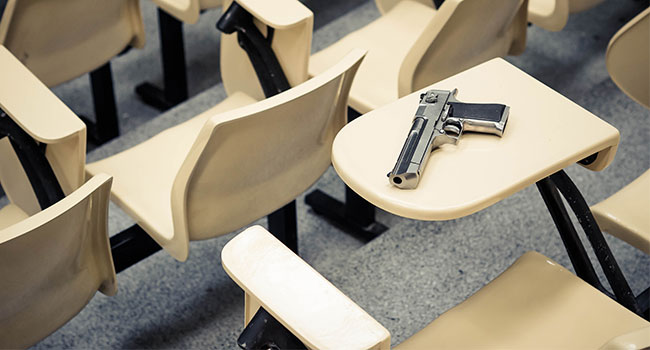
More Guns are the Last Things We Need in Our Schools
This ill-advised idea of arming teachers could lead to more shootings with innocent people being caught in the crossfire
- By Patrick V. Fiel
- February 28, 2018
A new idea seems to be gaining some traction in an effort to stop shootings on K-12 campuses: arming teachers. In the wake of the school shooting that killed 17, President Trump and the National Rifle Association's main proposal to prevent another tragedy like the one in Parkland, FL., has been to arm teachers.
This ill-advised idea of arming teachers could lead to more shootings with innocent people being caught in the crossfire. There would be more opportunities for guns to be stolen or taken by force; and armed teachers would unlikely provide much of a difference when a student gunman has the advantage of surprise.
Teachers need to concentrate primarily on their job of educating students; yet, they can play a role in helping to identify troubled students that need counseling or professional psychological intervention.
Teachers (and staff, too) should take every threat and student tip of potential violence seriously and fully check up on each claim, never assume that any talk of violence is just an idle threat.
If there is an active shooter on campus, teachers and staff need to let law enforcement officials handle the situation. Police officers have been fully trained on how and when to use their weapons. They have other tactical advantages, as well as trained hostage negotiators available, if necessary.
Rather than arm teachers, take a look at some of the following recommendations:
Implement a close-campus policy. All schools must be closed to outsiders until they are cleared to enter through a single controlled entrance. All other doors should remain locked throughout the day.
Make sure every school has a police officer (often called a school resource officer) assigned to the campus throughout each school day. In case of a shooting or other act of violence, a trained first responder can initiate action within seconds, not minutes.
Conduct random searches of student lockers and cars, restrooms, stairwells, and other places where a weapon may be hidden. The idea is to keep students off balance and show that a policy of zero-tolerance for weapons will be strictly enforced. Also, it is wise to keep the landscaping trimmed and at a minimum and have campus gardeners check outdoor places where a student might hide a weapon.
Complete a risk assessment of the campus, and as a result, prepare an emergency plan to use in a crisis situation. By practicing the plan frequently, teachers and students will know how to react during an emergency and minimize chaos. This also helps keep parents informed.
Consider the use of electronic security technology to help reduce the likelihood of death or injury from a campus gunman. Metal detectors can help spot guns, knives, and other weapons at the school entry. Video surveillance cameras can create an added layer of security, giving school security officers a better idea of what is happening in and around the campus before, during, and after a crisis. Also, if the video is transmitted over a district network, it is possible to allow law enforcement personnel to view the cameras from their emergency command center and for the responding officers to view this from their vehicles.
The main elements to an emergency plan are prevention, preparedness, response, and recovery. Minimizing injury and property damage in an emergency situation is all about careful, meticulous planning and a great deal of practice. Arming teachers on campus is not going to save lives, but rather complicate the job of keeping people safe.
About the Author
Patrick V. Fiel, Sr. is a national security consultant. He has over 35 years of experience managing law enforcement and security organization. He has served as the Public Safety Advisor for a large security integrator, Executive Director of Security for the Washington, D.C. Public School System, and is retired from the U.S. Army Military Police Corps. He can be reached at (910) 789-4265 or at [email protected].